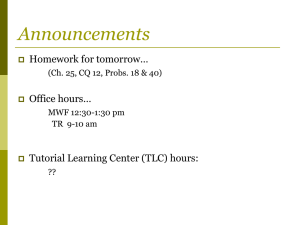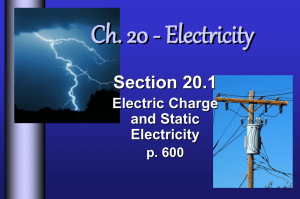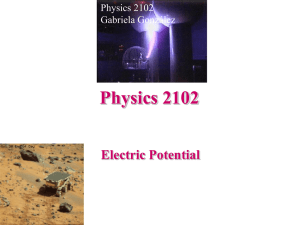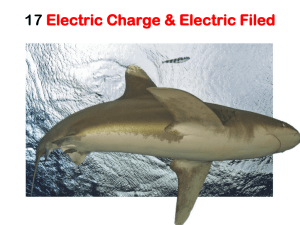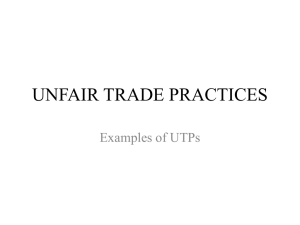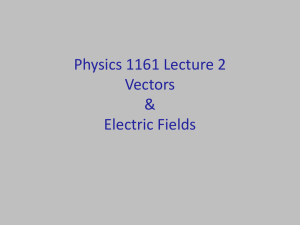Document
advertisement
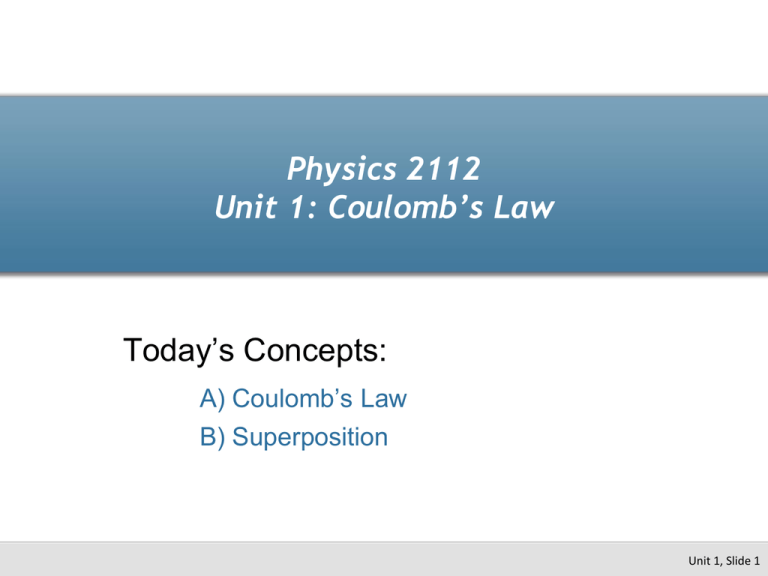
Physics 2112 Unit 1: Coulomb’s Law Today’s Concepts: A) Coulomb’s Law B) Superposition Unit 1, Slide 1 Electric Charges Electric charges come in two sign: + and - Why? Like sign charges repel, Opposite sign charges attract. Why? Electric charge is “quantized”. qe=1.602 X 10-19C Why? Charge of electron is exactly same as charge of proton How?! Unit 1, Slide 2 Electric Charges Electric charges is conserved At Fermilab -1 anti-proton +1 proton Unit 1, Slide 3 Electric Charges Tend to lose electrons when rubbed Tribo-electric Series Tend to gain electrons when rubbed Unit 1, Slide 4 Conductors / Insulators Conductors – charges are free to move anywhere on the conductor Insulators - charges remain where they are place except in cases of “extreme” force Unit 1, Slide 5 Electro-static Force The force on a charge due to another charge is proportional to the product of the charges and inversely proportional to the separation squared. q2 q1 F q1 q 2 r r 2 The force is always parallel to a line connecting the charges, but the direction depends on the signs of the charges: q2 q1 q2 q1 q2 q1 Opposite signs attract Like signs repel Unit 1, Slide 6 Coulomb’s Law q1 q 2 2 F1 , 2 k 2 rˆ1 , 2 r1 , 2 k = 9 X 109 N m2/C2 Unit of Charge is Columb (C) (big!) qe=1.602 X 10-19C Charles-Augustin de Coulomb – French engineer who was a pioneer in torsion and soil mechanics. Electricity & Magnetism Lecture 1, Slide 7 Coulomb’s Law Our notation: F1, 2 is the force by 1 on 2 (think “by-on ”) rˆ12 is the unit vector that points from 1 to 2. kq 1 q 2 2 F1 , 2 rˆ1 , 2 2 r1 , 2 Examples: If the charges have the same sign, the force by charge 1 on charge 2 would be in the direction of r12 (to the right). q1 r1, 2 q2 F1, 2 If the charges have opposite sign, the force by charge 1 on charge 2 would be opposite the direction of r12 (left). q1 F 1, 2 r1, 2 q2 Electricity & Magnetism Lecture 1, Slide 8 Example 1.1 (forces between paper clips) Two 1 gram paperclips are separated by 10 meters. Then you remove 1 electron from each atom on the first paperclip and place it on the second one. What is the force between the two clips? Unit 1, Slide 9 Example 1.2 (forces between students) What would the force be between two 80kg students sitting two meters apart if the charge of the proton were 10-10% greater than the charge of an electron? Unit 1, Slide 10 CheckPoint: Forces on Two Charges Two charges q = + 1 μC and Q = +10 μC are placed near each other as shown in the figure below. Which of the following diagrams best depicts the forces acting on the charges: Electricity & Magnetism Lecture 1, Slide 11 Superposition If there are more than two charges present, the total force on any given charge is just the vector sum of the forces due to each of the other charges: q2 F1 F2,1 F4,1 F1 F3,1 q1 F3,1 F2,1 F4,1 q4 q3 F1 F2 ,1 F3 ,1 F4 ,1 ... Electricity & Magnetism Lecture 1, Slide 12 The direction of all forces changes by 180o – the magnitudes stay the same: q2 q2 F4,1 F4,1 F1 q1 F2,1 F1 F3,1 q3 q3 F2,1 F2,1 F3,1 q4 F1 q1 q4 F1 F2,1 F3,1 F3,1 F4,1 F1 F2 ,1 F3 ,1 F4 ,1 ... F4,1 F1 F2 ,1 F3 ,1 F4 ,1 ... Electricity & Magnetism Lecture 1, Slide 13 CheckPoint: Compare Forces Compare the magnitude of the net force on q in the two cases. A) |F1 | > |F2| B) |F1 | |F2| C) |F1 |< |F2| D) Depends on sign of q Q Q q q Q Q Case 1 Case 2 Electricity & Magnetism Lecture 1, Slide 14 CheckPoint: Force from Four Charges Four charged particles are placed on a circular ring with radius 3 m as shown below. A particle with charge Q is placed in the center of the ring y 3q x What is the direction of horizontal force on Q? A) Fx > 0 B) Fx 0 Q C) Fx < 0 q q q Electricity & Magnetism Lecture 1, Slide 15 Example 1.3 (Force on charge) q2 2m q1 -30uC +10uC kq 1 q 2 2 ˆ F1 , 2 r 1, 2 2 r1 , 2 q3 2m +25uC What is the force on q2? Electricity & Magnetism Lecture 1, Slide 16 Charge on a Conductor Charges are free to move on conductor + + + + + + + + + + + + + + + Charges always on very edge of conductor Unit 1, Slide 17 +

